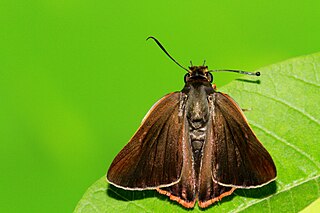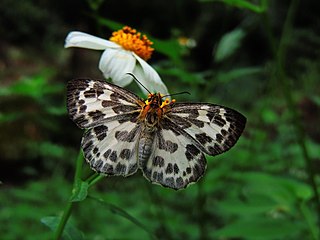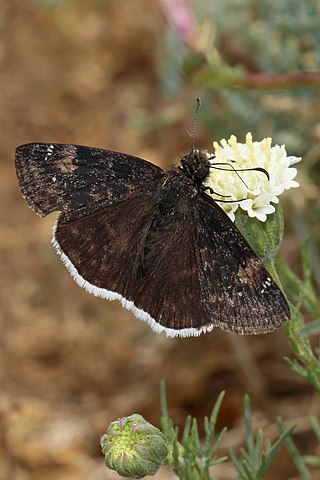
Skippers are a group of butterflies placed in the family Hesperiidae within the order Lepidoptera. They were previously placed in a separate superfamily, Hesperioidea; however, the most recent taxonomy places the family in the superfamily Papilionoidea, the butterflies. They are named for their quick, darting flight habits. Most have their antenna tips modified into narrow, hook-like projections. Moreover, skippers mostly have an absence of wing-coupling structure available in most moths. More than 3500 species of skippers are recognized, and they occur worldwide, but with the greatest diversity in the Neotropical regions of Central and South America.

Logan Botanic Garden is a botanical garden near Port Logan on the Rhins of Galloway, at the south-western tip of Scotland. It is operated as part of the Royal Botanic Garden Edinburgh's Living Collection. It has been described as "Scotland's most exotic garden."

Grass skippers or banded skippers are butterflies of the subfamily Hesperiinae, part of the skipper family, Hesperiidae. The subfamily was established by Pierre André Latreille in 1809.

Bibasis sena, commonly known as the orange-tailed awlet, is a butterfly belonging to the family Hesperiidae, the skippers. It is also sometimes called the pale green awlet though that name can also refer to Bibasis gomata.

The Pyrgini are a tribe in the skipper butterfly subfamily Pyrginae. Formerly, when only four tribes of Pyrginae were recognized, the Pyrgini contained the largest number of genera among these. But this overly wide delimitation has since turned out to be paraphyletic.

Epargyreus is the genus of flasher butterflies, in the subfamily Eudaminae of skipper butterflies. The species are found in the Nearctic and Neotropical realms.

The Tagiadini are a tribe of skipper butterflies in the family Hesperiidae. Many of its genera were of uncertain relationships for long, and delimitation of the Tagiadini versus the Celaenorrhinini was quite disputed at times. The species of this tribe are found in mostly tropical regions of Africa, Asia and Australia.

The Celaenorrhinini are a tribe of spread-winged skippers in the skipper butterfly subfamily Tagiadinae.

Euschemon is a genus of skipper butterflies in the family Hesperiidae. It is monotypic, being represented by the single species Euschemon rafflesia, commonly known as the regent skipper and is found in Australia.

Abraximorpha is a small South Asian genus of skippers in the family Hesperiidae.

Acerbas is an Indomalayan genus of skipper butterflies.

Agathymus is a genus of butterflies in the skipper family, Hesperiidae. They occur in the North American deserts. The genus was described by Hugh Avery Freeman in 1959. The larvae bore into the stems of agave plants.

Atrytonopsis is a genus of butterflies in the skipper family, Hesperiidae. They are native to Mexico and the southwestern United States.

Quasimellana is a genus of skippers in the family Hesperiidae with a distribution in South America and southern North America.

Anatrytone logan, the Delaware skipper, is a North American butterfly. It is a member of the subfamily Hesperiinae, the grass skippers. This skipper ranges from the southern Canadian Prairies and southern Ontario through the midwestern and eastern United States.

The Carcharodini are a tribe in the skipper butterfly subfamily Pyrginae. They are a very diverse but quite plesiomorphic and inconspicuous group distributed throughout the tropics.

The Erynnini are a tribe in the skipper butterfly subfamily Pyrginae. They are a moderately diverse but quite plesiomorphic and inconspicuous group, and except for the Holarctic species of the type genus Erynnis occur only in the Neotropics.

Olafia is a genus of skippers in the family Hesperiidae. It contains only one species, Olafia roscius, which is found in Brazil and Argentina.


















